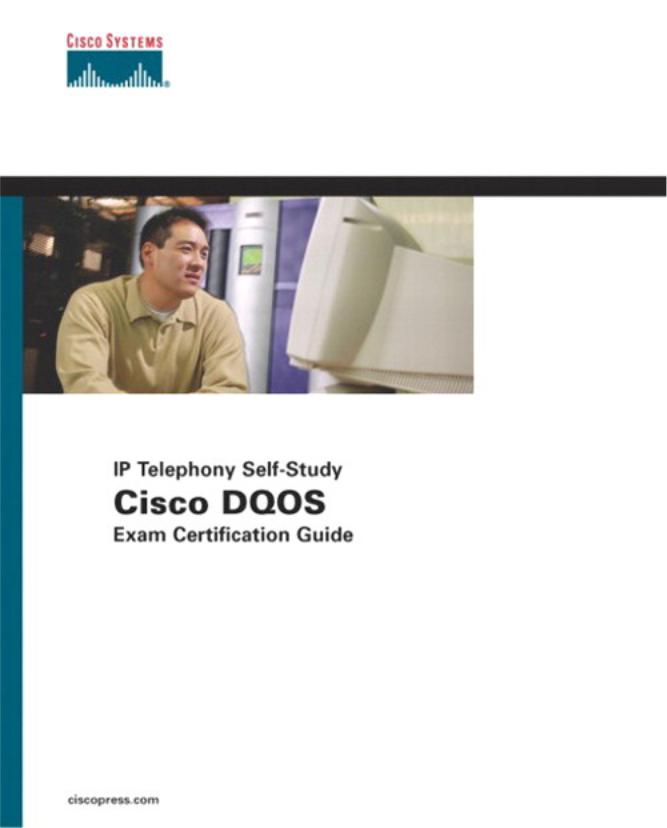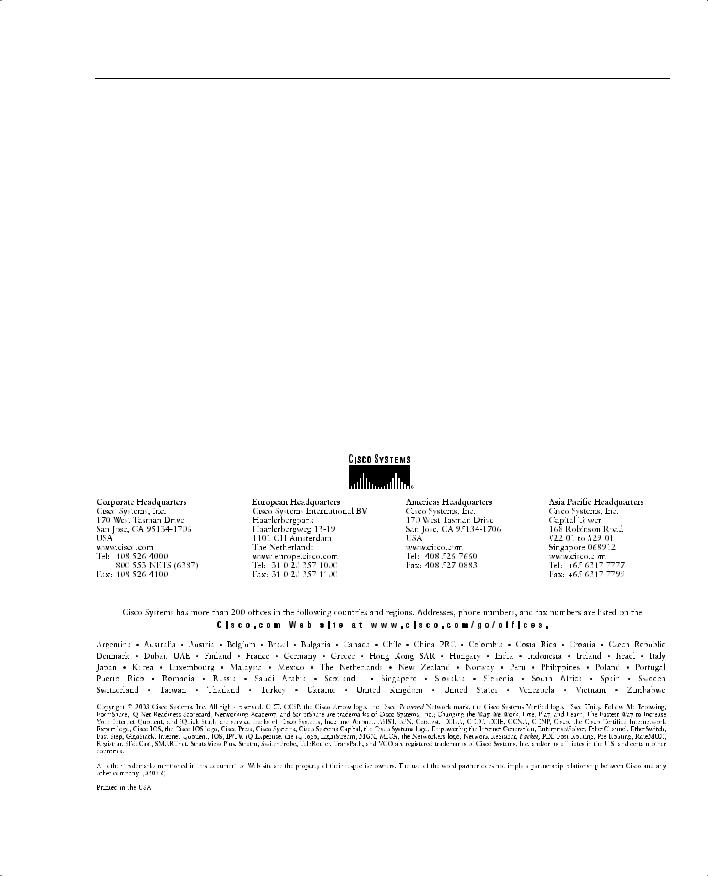
- •QoS Overview
- •“Do I Know This Already?” Quiz
- •QoS: Tuning Bandwidth, Delay, Jitter, and Loss Questions
- •Foundation Topics
- •QoS: Tuning Bandwidth, Delay, Jitter, and Loss
- •Bandwidth
- •The clock rate Command Versus the bandwidth Command
- •QoS Tools That Affect Bandwidth
- •Delay
- •Serialization Delay
- •Propagation Delay
- •Queuing Delay
- •Forwarding Delay
- •Shaping Delay
- •Network Delay
- •Delay Summary
- •QoS Tools That Affect Delay
- •Jitter
- •QoS Tools That Affect Jitter
- •Loss
- •QoS Tools That Affect Loss
- •Summary: QoS Characteristics: Bandwidth, Delay, Jitter, and Loss
- •Voice Basics
- •Voice Bandwidth Considerations
- •Voice Delay Considerations
- •Voice Jitter Considerations
- •Voice Loss Considerations
- •Video Basics
- •Video Bandwidth Considerations
- •Video Delay Considerations
- •Video Jitter Considerations
- •Video Loss Considerations
- •Comparing Voice and Video: Summary
- •IP Data Basics
- •Data Bandwidth Considerations
- •Data Delay Considerations
- •Data Jitter Considerations
- •Data Loss Considerations
- •Comparing Voice, Video, and Data: Summary
- •Foundation Summary
- •QoS Tools and Architectures
- •“Do I Know This Already?” Quiz
- •QoS Tools Questions
- •Differentiated Services Questions
- •Integrated Services Questions
- •Foundation Topics
- •Introduction to IOS QoS Tools
- •Queuing
- •Queuing Tools
- •Shaping and Policing
- •Shaping and Policing Tools
- •Congestion Avoidance
- •Congestion-Avoidance Tools
- •Call Admission Control and RSVP
- •CAC Tools
- •Management Tools
- •Summary
- •The Good-Old Common Sense QoS Model
- •GOCS Flow-Based QoS
- •GOCS Class-Based QoS
- •The Differentiated Services QoS Model
- •DiffServ Per-Hop Behaviors
- •The Class Selector PHB and DSCP Values
- •The Assured Forwarding PHB and DSCP Values
- •The Expedited Forwarding PHB and DSCP Values
- •The Integrated Services QoS Model
- •Foundation Summary
- •“Do I Know This Already?” Quiz Questions
- •CAR, PBR, and CB Marking Questions
- •Foundation Topics
- •Marking
- •IP Header QoS Fields: Precedence and DSCP
- •LAN Class of Service (CoS)
- •Other Marking Fields
- •Summary of Marking Fields
- •Class-Based Marking (CB Marking)
- •Network-Based Application Recognition (NBAR)
- •CB Marking show Commands
- •CB Marking Summary
- •Committed Access Rate (CAR)
- •CAR Marking Summary
- •Policy-Based Routing (PBR)
- •PBR Marking Summary
- •VoIP Dial Peer
- •VoIP Dial-Peer Summary
- •Foundation Summary
- •Congestion Management
- •“Do I Know This Already?” Quiz
- •Queuing Concepts Questions
- •WFQ and IP RTP Priority Questions
- •CBWFQ and LLQ Questions
- •Comparing Queuing Options Questions
- •Foundation Topics
- •Queuing Concepts
- •Output Queues, TX Rings, and TX Queues
- •Queuing on Interfaces Versus Subinterfaces and Virtual Circuits (VCs)
- •Summary of Queuing Concepts
- •Queuing Tools
- •FIFO Queuing
- •Priority Queuing
- •Custom Queuing
- •Weighted Fair Queuing (WFQ)
- •WFQ Scheduler: The Net Effect
- •WFQ Scheduling: The Process
- •WFQ Drop Policy, Number of Queues, and Queue Lengths
- •WFQ Summary
- •Class-Based WFQ (CBWFQ)
- •CBWFQ Summary
- •Low Latency Queuing (LLQ)
- •LLQ with More Than One Priority Queue
- •IP RTP Priority
- •Summary of Queuing Tool Features
- •Foundation Summary
- •Conceptual Questions
- •Priority Queuing and Custom Queuing
- •CBWFQ, LLQ, IP RTP Priority
- •Comparing Queuing Tool Options
- •“Do I Know This Already?” Quiz
- •Shaping and Policing Concepts Questions
- •Policing with CAR and CB Policer Questions
- •Shaping with FRTS, GTS, DTS, and CB Shaping
- •Foundation Topics
- •When and Where to Use Shaping and Policing
- •How Shaping Works
- •Where to Shape: Interfaces, Subinterfaces, and VCs
- •How Policing Works
- •CAR Internals
- •CB Policing Internals
- •Policing, but Not Discarding
- •Foundation Summary
- •Shaping and Policing Concepts
- •“Do I Know This Already?” Quiz
- •Congestion-Avoidance Concepts and RED Questions
- •WRED Questions
- •FRED Questions
- •Foundation Topics
- •TCP and UDP Reactions to Packet Loss
- •Tail Drop, Global Synchronization, and TCP Starvation
- •Random Early Detection (RED)
- •Weighted RED (WRED)
- •How WRED Weights Packets
- •WRED and Queuing
- •WRED Summary
- •Flow-Based WRED (FRED)
- •Foundation Summary
- •Congestion-Avoidance Concepts and Random Early Detection (RED)
- •Weighted RED (WRED)
- •Flow-Based WRED (FRED)
- •“Do I Know This Already?” Quiz
- •Compression Questions
- •Link Fragmentation and Interleave Questions
- •Foundation Topics
- •Payload and Header Compression
- •Payload Compression
- •Header Compression
- •Link Fragmentation and Interleaving
- •Multilink PPP LFI
- •Maximum Serialization Delay and Optimum Fragment Sizes
- •Frame Relay LFI Using FRF.12
- •Choosing Fragment Sizes for Frame Relay
- •Fragmentation with More Than One VC on a Single Access Link
- •FRF.11-C and FRF.12 Comparison
- •Foundation Summary
- •Compression Tools
- •LFI Tools
- •“Do I Know This Already?” Quiz
- •Foundation Topics
- •Call Admission Control Overview
- •Call Rerouting Alternatives
- •Bandwidth Engineering
- •CAC Mechanisms
- •CAC Mechanism Evaluation Criteria
- •Local Voice CAC
- •Physical DS0 Limitation
- •Max-Connections
- •Voice over Frame Relay—Voice Bandwidth
- •Trunk Conditioning
- •Local Voice Busyout
- •Measurement-Based Voice CAC
- •Service Assurance Agents
- •SAA Probes Versus Pings
- •SAA Service
- •Calculated Planning Impairment Factor
- •Advanced Voice Busyout
- •PSTN Fallback
- •SAA Probes Used for PSTN Fallback
- •IP Destination Caching
- •SAA Probe Format
- •PSTN Fallback Scalability
- •PSTN Fallback Summary
- •Resource-Based CAC
- •Resource Availability Indication
- •Gateway Calculation of Resources
- •RAI in Service Provider Networks
- •RAI in Enterprise Networks
- •RAI Operation
- •RAI Platform Support
- •Cisco CallManager Resource-Based CAC
- •Location-Based CAC Operation
- •Locations and Regions
- •Calculation of Resources
- •Automatic Alternate Routing
- •Location-Based CAC Summary
- •Gatekeeper Zone Bandwidth
- •Gatekeeper Zone Bandwidth Operation
- •Single-Zone Topology
- •Multizone Topology
- •Zone-per-Gateway Design
- •Gatekeeper in CallManager Networks
- •Zone Bandwidth Calculation
- •Gatekeeper Zone Bandwidth Summary
- •Integrated Services / Resource Reservation Protocol
- •RSVP Levels of Service
- •RSVP Operation
- •RSVP/H.323 Synchronization
- •Bandwidth per Codec
- •Subnet Bandwidth Management
- •Monitoring and Troubleshooting RSVP
- •RSVP CAC Summary
- •Foundation Summary
- •Call Admission Control Concepts
- •Local-Based CAC
- •Measurement-Based CAC
- •Resources-Based CAC
- •“Do I Know This Already?” Quiz
- •QoS Management Tools Questions
- •QoS Design Questions
- •Foundation Topics
- •QoS Management Tools
- •QoS Device Manager
- •QoS Policy Manager
- •Service Assurance Agent
- •Internetwork Performance Monitor
- •Service Management Solution
- •QoS Management Tool Summary
- •QoS Design for the Cisco QoS Exams
- •Four-Step QoS Design Process
- •Step 1: Determine Customer Priorities/QoS Policy
- •Step 2: Characterize the Network
- •Step 3: Implement the Policy
- •Step 4: Monitor the Network
- •QoS Design Guidelines for Voice and Video
- •Voice and Video: Bandwidth, Delay, Jitter, and Loss Requirements
- •Voice and Video QoS Design Recommendations
- •Foundation Summary
- •QoS Management
- •QoS Design
- •“Do I Know This Already?” Quiz
- •Foundation Topics
- •The Need for QoS on the LAN
- •Layer 2 Queues
- •Drop Thresholds
- •Trust Boundries
- •Cisco Catalyst Switch QoS Features
- •Catalyst 6500 QoS Features
- •Supervisor and Switching Engine
- •Policy Feature Card
- •Ethernet Interfaces
- •QoS Flow on the Catalyst 6500
- •Ingress Queue Scheduling
- •Layer 2 Switching Engine QoS Frame Flow
- •Layer 3 Switching Engine QoS Packet Flow
- •Egress Queue Scheduling
- •Catalyst 6500 QoS Summary
- •Cisco Catalyst 4500/4000 QoS Features
- •Supervisor Engine I and II
- •Supervisor Engine III and IV
- •Cisco Catalyst 3550 QoS Features
- •Cisco Catalyst 3524 QoS Features
- •CoS-to-Egress Queue Mapping for the Catalyst OS Switch
- •Layer-2-to-Layer 3 Mapping
- •Connecting a Catalyst OS Switch to WAN Segments
- •Displaying QoS Settings for the Catalyst OS Switch
- •Enabling QoS for the Catalyst IOS Switch
- •Enabling Priority Queuing for the Catalyst IOS Switch
- •CoS-to-Egress Queue Mapping for the Catalyst IOS Switch
- •Layer 2-to-Layer 3 Mapping
- •Connecting a Catalyst IOS Switch to Distribution Switches or WAN Segments
- •Displaying QoS Settings for the Catalyst IOS Switch
- •Foundation Summary
- •LAN QoS Concepts
- •Catalyst 6500 Series of Switches
- •Catalyst 4500/4000 Series of Switches
- •Catalyst 3550/3524 Series of Switches
- •QoS: Tuning Bandwidth, Delay, Jitter, and Loss
- •QoS Tools
- •Differentiated Services
- •Integrated Services
- •CAR, PBR, and CB Marking
- •Queuing Concepts
- •WFQ and IP RTP Priority
- •CBWFQ and LLQ
- •Comparing Queuing Options
- •Conceptual Questions
- •Priority Queuing and Custom Queuing
- •CBWFQ, LLQ, IP RTP Priority
- •Comparing Queuing Tool Options
- •Shaping and Policing Concepts
- •Policing with CAR and CB Policer
- •Shaping with FRTS, GTS, DTS, and CB Shaping
- •Shaping and Policing Concepts
- •Congestion-Avoidance Concepts and RED
- •WRED
- •FRED
- •Congestion-Avoidance Concepts and Random Early Detection (RED)
- •Weighted RED (WRED)
- •Flow-Based WRED (FRED)
- •Compression
- •Link Fragmentation and Interleave
- •Compression Tools
- •LFI Tools
- •Call Admission Control Concepts
- •Local-Based CAC
- •Measurement-Based CAC
- •Resources-Based CAC
- •QoS Management Tools
- •QoS Design
- •QoS Management
- •QoS Design
- •LAN QoS Concepts
- •Catalyst 6500 Series of Switches
- •Catalyst 4500/4000 Series of Switches
- •Catalyst 3550/3524 Series of Switches
- •Foundation Topics
- •QPPB Route Marking: Step 1
- •QPPB Per-Packet Marking: Step 2
- •QPPB: The Hidden Details
- •QPPB Summary
- •Flow-Based dWFQ
- •ToS-Based dWFQ
- •Distributed QoS Group–Based WFQ
- •Summary: dWFQ Options


IP Telephony Self-Study
Cisco DQOS
Exam Certification Guide
Wendell Odom, CCIE No. 1624 Michael J. Cavanaugh, CCIE No. 4516
Cisco Press
Cisco Press
201 West 103rd Street
Indianapolis, IN 46290 USA

ii
IP Telephony Self-Study
Cisco DQOS Exam Certification Guide
Wendell Odom and Michael J. Cavanaugh
Copyright © 2004 Cisco Systems, Inc.
Cisco Press logo is a trademark of Cisco Systems, Inc.
Published by: Cisco Press
201 West 103rd Street Indianapolis, IN 46290 USA
All rights reserved. No part of this book may be reproduced or transmitted in any form or by any means, electronic or mechanical, including photocopying, recording, or by any information storage and retrieval system, without written permission from the publisher, except for the inclusion of brief quotations in a review.
Printed in the United States of America 1 2 3 4 5 6 7 8 9 0
Library of Congress Cataloging-in-Publication Number: 2001097407
ISBN: 1-58720-058-9
First Printing July 2003
Warning and Disclaimer
This book is designed to provide information about quality of service (QoS) for the Cisco Catalyst switch platform. Every effort has been made to make this book as complete and as accurate as possible, but no warranty or fitness is implied.
The information is provided on an “as is” basis. The authors, Cisco Press, and Cisco Systems, Inc. shall have neither liability nor responsibility to any person or entity with respect to any loss or damages arising from the information contained in this book or from the use of the discs or programs that may accompany it.
The opinions expressed in this book belong to the author and are not necessarily those of Cisco Systems, Inc.
Trademark Acknowledgments
All terms mentioned in this book that are known to be trademarks or service marks have been appropriately capitalized. Cisco Press or Cisco Systems, Inc. cannot attest to the accuracy of this information. Use of a term in this book should not be regarded as affecting the validity of any trademark or service mark.
These materials have been reproduced by Pearson Technology Group with the permission of Cisco Systems Inc. COPYRIGHT © 2003 CISCO SYSTEMS, INC. ALL RIGHTS RESERVED.
Feedback Information
At Cisco Press, our goal is to create in-depth technical books of the highest quality and value. Each book is crafted with care and precision, undergoing rigorous development that involves the unique expertise of members from the professional technical community.
Readers’ feedback is a natural continuation of this process. If you have any comments regarding how we could improve the quality of this book, or otherwise alter it to better suit your needs, you can contact us through e-mail at feedback@ciscopress.com. Please make sure to include the book title and ISBN in your message.
We greatly appreciate your assistance.

iii
Publisher |
John Wait |
Editor-In-Chief |
John Kane |
Cisco Representative |
Anthony Wolfenden |
Cisco Press Program Manager |
Sonia Torres Chavez |
Cisco Marketing Communications |
Scott Miller |
Manager |
|
Cisco Marketing Program Manager |
Edie Quiroz |
Executive Editor |
Brett Bartow |
Production Manager |
Patrick Kanouse |
Development Editor |
Ginny Bess Munroe |
Copy Editor |
Keith Cline |
Technical Editors |
Frank Knox and Tim Szigeti |
Team Coordinator |
Tammi Ross |
Book Designer |
Gina Rexrode |
Cover Designer |
Louisa Klucznik |
Compositor |
Octal Publishing, Inc. |
Indexer |
Larry Sweazy |
Proofreader |
Missy Pluta |

iv
About the Authors
Wendell Odom, CCIE No. 1624, is a senior instructor with Skyline Computer (www.skylinecomputer.com). Wendell has worked in the networking arena for 20 years, working in preand post-sales technical consulting, teaching, and course development. He has authored portions of over 12 courses, including topics such as IP routing, MPLS, Cisco WAN switches, SNA protocols, and LAN troubleshooting. He is author of the bestselling Cisco Press title CCNA Exam Certification Guide.
Michael J. Cavanaugh, CCIE No. 4516, has been in the networking industry for over 17 years. His employment with such companies as General Electric, Cisco Systems, and Bellsouth Communication Systems has allowed him to stay at the forefront of technology and hold leading edge certifications. His current focus is AVVID implementations, providing convergance consulting, professional services, and technical support. Michael’s passion is learning the practical applications of new technologies and sharing knowledge with fellow engineers.
About the Technical Reviewers
Frank Knox, CCIE No. 3698 (Routing & Switching and SNA-IP), is currently the chief technology officer for Skyline Computer Corporation. Frank also participates in the business as a consultant and instructor in the areas of design, implementation, and customer training for all aspects of networking, including IP telephony. Frank has more than 35 years of networking experience with IBM, GTE, and Skyline Computer. During that time, he has worked in field service and support, product planning, education, and management. In addition, he has developed and taught several courses for the University of Dallas (Telecommunications MBA program). Frank has a master’s degree in telecommunications from Pace University.
Tim Szigeti, CCIE No. 9794, is a member of the Enterprise Solutions Engineering design team at Cisco Systems. In this role, he works closely with customers and engineering to develop advanced, scalable, and tested solutions for the Cisco AVVID Network Infrastructure (CANI). Prior to this, he was performing technical marketing and product management within the Enterprise Management Business Unit, specializing in QoS Management.
Dedications
Wendell Odom: Mike Zanotto, or Mike Z as he’s known throughout California and the world, has had a significant impact on my personal involvement with this book. Mike let me start our company’s efforts to teach DQOS classes back in 2001—even when it didn’t look like the class would be that popular—just because it might turn into more. Well, it turned out to be a great move for Skyline Computer, and for me. Mike’s willingness to take chances like that has had a lot to do with Skyline’s success over the years. As my boss, he makes it possible for me to have time to write without totally destroying all of my time for my family! As a friend, he helps keep me laughing, and not take the networking world too seriously. Mike Z, thanks for helping make this book possible!
Michael J. Cavanaugh: I would like to dedicate this book to my lovely wife KC and beautiful daughter Caitlin for their love and support through the years, but especially as I took my first steps in writing. I would like to thank Wendell Odom for giving me the opportunity to co-author this book. It has been an exciting and challenging experience. I would also like to thank all of the people at Cisco Press and the technical editors that made this book a reality.

v
Acknowledgments
My uncle Eulie used to work in the meat market in the small town I grew up in. I loved hot dogs—but he’d never let me see how they made them!! He always told me that if I liked them, then I really didn’t want to know how they were made!
This book has taken a while to complete, with several distractions from all directions. The path we all took to complete this book was a little messy—like making hot dogs, I’m sure—and two individuals in particular made this book possible in spite of the interruptions and diversions.
Michael Cavanaugh, my co-author, worked tirelessly to finish several key components of the book. His vast practical skills have improved the book tremendously. Michael got to do some of the more challenging parts of the book, and under duress—Michael, thanks so much for making the difference!
Ginny Bess, the development editor for this book, got the opportunity to jump into the mix mid-project. While many people contribute to the success of any book, the development editor is the author’s main contact for submitting and editing the content. When Gin came on board, we didn’t miss a beat, with book development running very smoothly.
When job responsibilities required a change in development editors mid-stream, we knew it was a risk, but Ginny came through and did an excellent job.
Chris Cleveland started the book development and gave us guidance as needed. Chris’s primary focus is to make the author’s life easier, and as always, he succeeded. Thanks for the usual stellar job!
Brett Bartow, executive editor for this project, happens to be an avid baseball fan, as am I. Brett’s job requires that he be able to “hit major league curveballs”—for you non-baseball fans, that means he can hit a moving target with the best of them. Once again, Brett, your steady hand throughout the entire writing and editing process helped make this project a success. Thanks for staying on top of the positioning and business issues relating to the book.
Moreso than for most books, this book required some extra effort on the figures in the book. Amy Parker created several new icons for this book, with these icons representing some relatively complex concepts. Amy came through for us, taking my general comments and rough ideas, in some cases refining them, and in others coming up with whole new (and much better) ways to represent the concepts. Thanks much!
Finally, the production side of the business does not get as much notice, because the author (me) who writes these acknowledgements seldom works directly with them. Over the last few years, I’ve gotten to see more of their work, and believe me, I really do have the easy part of the job. I deliver Word documents and Powerpoint (rough) drawings—and all production does is somehow make this wonderfully polished book appear. Thanks for making me look good again, and again, and again!
As usual, the technical editors deserve most of the credit for making the content of this book robust and complete. For this edition, Tim Szigeti and Frank Knox did the technical editing. Tim’s job requires that he help define and evangelize what Cisco views as “best practices” for QoS deployments. His practical experience and ability to communicate well helped us make this book a much more practical reference. Tim, thanks for your work and your patience in helping us resolve the occasional difference between what’s on the exams and in the QoS courses, as compared with Cisco’s suggested best practices!
Frank Knox, dual CCIE and someone I personally credit with getting me interested in the training world 15 years ago, also worked hard on the technical editing process. Frank’s no-nonsense approach to editing, with an occasional nonsensical joke thrown in, both helped the manuscript improve, and kept me a little saner during my re-work of the chapters based on his comments. Thanks to you both for making this book so much better!
Ultimately, Michael and I are most responsible for the contents of the book, so any errors you find are certainly our fault. However, if you do think you found an error, the best way to get in touch to report the error is to go to www.ciscopress.com, click on the “Contact Us” tab, and fill in the form. When it’s something that needs a look from the authors, the information gets to us expediently. If it’s a problem that can be handled by the publisher, they can get to it even more quickly!
Finally, no section called acknowledgments could be complete without acknowledging a few others. My wife, Kris, regularly takes on all the load for practical stuff at home, instead of the usual majority of the load, when a book project comes down to the wire. This time around, we had three books on similar deadlines. As always, Kris, thanks for helping me when the timing is tight! And ultimately, in this book effort and all else, I must acknowledge Jesus Christ, my friend, intercessor, and savior!

vi
Contents at a Glance
|
Foreword xvii |
|
|
|
Introduction |
xviii |
|
Chapter 1 |
QoS Overview 3 |
|
|
Chapter 2 |
QoS Tools and Architectures |
83 |
|
Chapter 3 |
Classification and Marking |
155 |
|
Chapter 4 |
Congestion Management 233 |
||
Chapter 5 |
Traffic Policing and Shaping |
319 |
|
Chapter 6 |
Congestion Avoidance Through Drop Policies 425 |
||
Chapter 7 |
Link-Efficiency Tools 479 |
|
|
Chapter 8 |
Call Admission Control and QoS Signaling 541 |
||
Chapter 9 |
Management Tools and QoS Design 657 |
||
Chapter 10 |
LAN QoS |
687 |
|
Appendix A |
Answers to the “Do I Know This Already?” Quizzes and Q&A Sections 763 |
||
Appendix B |
Topics on the CCIP QoS Exam 831 |
||
Index 883 |
|
|
|

vii
Table of Contents
Foreword |
xvii |
|
|
|
|
|
|
|
|
Introduction |
xviii |
|
|
|
|
|
|
|
|
Chapter 1 QoS Overview |
3 |
|
|
|
|
|
|
|
|
“Do I Know This Already?” Quiz |
|
3 |
|
|
|
||||
QoS: Tuning Bandwidth, Delay, Jitter, and Loss Questions |
4 |
||||||||
Traffic Characteristics of Voice, Video, and Data Questions |
5 |
||||||||
Foundation Topics 6 |
|
|
|
|
|
|
|
||
QoS: Tuning Bandwidth, Delay, Jitter, and Loss |
7 |
|
|||||||
Bandwidth |
9 |
|
|
|
|
|
|
|
|
The clock rate Command Versus the bandwidth Command 11 |
|||||||||
QoS Tools That Affect Bandwidth |
11 |
|
|
||||||
Delay |
13 |
|
|
|
|
|
|
|
|
Serialization Delay |
14 |
|
|
|
|
|
|||
Propagation Delay |
16 |
|
|
|
|
|
|||
Queuing Delay |
18 |
|
|
|
|
|
|
||
Forwarding Delay |
20 |
|
|
|
|
|
|||
Shaping Delay |
20 |
|
|
|
|
|
|
||
Network Delay |
22 |
|
|
|
|
|
|
||
Delay Summary 23 |
|
|
|
|
|
||||
QoS Tools That Affect Delay 24 |
|
|
|
||||||
Jitter |
27 |
|
|
|
|
|
|
|
|
QoS Tools That Affect Jitter |
28 |
|
|
|
|||||
Loss |
29 |
|
|
|
|
|
|
|
|
QoS Tools That Affect Loss |
29 |
|
|
|
|||||
Summary: QoS Characteristics: Bandwidth, Delay, Jitter, and Loss 32 |
|||||||||
Traffic Characteristics of Voice, Video, and Data |
32 |
|
|||||||
Voice Traffic Characteristics |
33 |
|
|
|
|||||
Voice Basics |
33 |
|
|
|
|
|
|
||
Voice Bandwidth Considerations |
36 |
|
|
||||||
Voice Delay Considerations |
39 |
|
|
|
|||||
Voice Jitter Considerations |
|
48 |
|
|
|
||||
Voice Loss Considerations |
|
49 |
|
|
|
||||
Video Traffic Characteristics |
52 |
|
|
|
|||||
Video Basics |
52 |
|
|
|
|
|
|
||
Video Bandwidth Considerations |
54 |
|
|
||||||
Video Delay Considerations |
55 |
|
|
|
|||||
Video Jitter Considerations |
|
56 |
|
|
|
||||
Video Loss Considerations |
|
57 |
|
|
|
||||
Comparing Voice and Video: Summary |
57 |
|
|||||||

viii
Data Traffic Characteristics |
57 |
|
|
|
|
||||||
IP Data Basics |
58 |
|
|
|
|
|
|
|
|
||
Data Bandwidth Considerations |
63 |
|
|
||||||||
Data Delay Considerations |
64 |
|
|
|
|||||||
Data Jitter Considerations |
|
64 |
|
|
|
|
|||||
Data Loss Considerations |
|
65 |
|
|
|
|
|||||
Comparing Voice, Video, and Data: Summary 66 |
|
||||||||||
Foundation Summary |
67 |
|
|
|
|
|
|
|
|
||
Q&A 79 |
|
|
|
|
|
|
|
|
|
|
|
Chapter 2 QoS Tools and Architectures |
83 |
|
|
|
|
|
|||||
“Do I Know This Already?” Quiz |
83 |
|
|
|
|
||||||
QoS Tools Questions |
84 |
|
|
|
|
|
|
||||
Differentiated Services Questions |
85 |
|
|
||||||||
Integrated Services Questions |
85 |
|
|
|
|
||||||
Foundation Topics |
86 |
|
|
|
|
|
|
|
|
|
|
Introduction to IOS QoS Tools |
86 |
|
|
|
|
||||||
Classification and Marking |
86 |
|
|
|
|
||||||
Classification and Marking Tools |
89 |
|
|
||||||||
Queuing |
90 |
|
|
|
|
|
|
|
|
|
|
Queuing Tools |
91 |
|
|
|
|
|
|
|
|
||
Shaping and Policing |
93 |
|
|
|
|
|
|
||||
Shaping and Policing Tools |
95 |
|
|
|
|||||||
Congestion Avoidance |
|
96 |
|
|
|
|
|
|
|||
Congestion-Avoidance Tools |
97 |
|
|
||||||||
Link Efficiency |
97 |
|
|
|
|
|
|
|
|
||
Link-Efficiency Tools: Summary |
99 |
|
|
||||||||
Call Admission Control and RSVP |
|
100 |
|
|
|||||||
CAC Tools |
101 |
|
|
|
|
|
|
|
|
||
Management Tools |
102 |
|
|
|
|
|
|
||||
Summary |
103 |
|
|
|
|
|
|
|
|
|
|
The Good-Old Common Sense QoS Model 104 |
|
||||||||||
GOCS Flow-Based QoS |
105 |
|
|
|
|
|
|||||
GOCS Class-Based QoS |
108 |
|
|
|
|
|
|||||
Classification and Marking at the Edge |
109 |
|
|||||||||
The Differentiated Services QoS Model |
114 |
|
|
||||||||
DiffServ Specifications and Terminology |
114 |
|
|||||||||
DiffServ Per-Hop Behaviors |
119 |
|
|
|
|
||||||
The Class Selector PHB and DSCP Values 121 |
|
||||||||||
The Assured Forwarding PHB and DSCP Values |
125 |
||||||||||
The Expedited Forwarding PHB and DSCP Values |
128 |
||||||||||

ix
DiffServ Classifiers and Traffic Conditioners 129 |
||||
The Integrated Services QoS Model |
133 |
|
|
|
Foundation Summary 137 |
|
|
|
|
Q&A 152 |
|
|
|
|
Chapter 3 Classification and Marking 155 |
|
|
|
|
“Do I Know This Already?” Quiz Questions |
155 |
|
||
Classification and Marking Concepts Questions |
156 |
|||
CAR, PBR, and CB Marking Questions |
157 |
|
||
Foundation Topics |
158 |
|
|
|
Classification and Marking Concepts |
158 |
|
|
|
Classification |
158 |
|
|
|
Marking 162 |
|
|
|
|
IP Header QoS Fields: Precedence and DSCP |
163 |
|||
LAN Class of Service (CoS) |
166 |
|
|
|
Other Marking Fields 168 |
|
|
|
|
Summary of Marking Fields |
168 |
|
|
|
Classification and Marking Design Choices 170 |
|
|||
Classification and Marking Tools |
175 |
|
|
|
Class-Based Marking (CB Marking) |
175 |
|
||
Network-Based Application Recognition (NBAR) |
185 |
|||
CB Marking show Commands |
189 |
|
||
CB Marking Summary 193 |
|
|
|
|
Committed Access Rate (CAR) |
193 |
|
|
|
CAR Marking Summary |
200 |
|
|
|
Policy-Based Routing (PBR) |
201 |
|
|
|
PBR Marking Summary |
207 |
|
|
|
VoIP Dial Peer 207 |
|
|
|
|
VoIP Dial-Peer Summary |
214 |
|
|
|
Summary of Classification and Marking QoS Features |
214 |
|||
Foundation Summary 217 |
|
|
|
|
Q&A 229 |
|
|
|
|
Chapter 4 Congestion Management 233 |
|
|
|
|
“Do I Know This Already?” Quiz |
233 |
|
|
|
Queuing Concepts Questions |
234 |
|
|
|
WFQ and IP RTP Priority Questions |
234 |
|
||
CBWFQ and LLQ Questions |
235 |
|
|
|
Comparing Queuing Options Questions 235 |
|
|||

x
Foundation Topics 236
Queuing Concepts 236
Output Queues, TX Rings, and TX Queues 239
Queuing on Interfaces Versus Subinterfaces and Virtual Circuits (VCs) 245
Summary of Queuing Concepts |
248 |
|||
Queuing Tools 248 |
|
|
|
|
FIFO Queuing |
249 |
|
|
|
Priority Queuing |
251 |
|
|
|
Custom Queuing |
254 |
|
|
|
Weighted Fair Queuing (WFQ) |
257 |
|||
WFQ Classification |
258 |
|
|
|
WFQ Scheduler: The Net Effect |
259 |
|||
WFQ Scheduling: The Process |
260 |
|||
WFQ Drop Policy, Number of Queues, and Queue Lengths 264 |
||||
WFQ Configuration |
266 |
|
|
|
WFQ Summary 271 |
|
|
||
Class-Based WFQ (CBWFQ) |
272 |
|
||
CBWFQ Configuration 275 |
|
|||
CBWFQ Summary |
287 |
|
|
|
Low Latency Queuing (LLQ) |
288 |
|
||
LLQ Configuration |
290 |
|
|
|
LLQ with More Than One Priority Queue 295 |
||||
IP RTP Priority |
296 |
|
|
|
IP RTP Priority Configuration |
297 |
|||
Summary of Queuing Tool Features |
299 |
|||
Foundation Summary 301
Q&A |
313 |
|
Conceptual Questions 313 |
|
|
Priority Queuing and Custom Queuing 313 |
||
WFQ |
314 |
|
CBWFQ, LLQ, IP RTP Priority |
314 |
|
Comparing Queuing Tool Options |
316 |
|
Chapter 5 Traffic Policing and Shaping 319 |
||
“Do I Know This Already?” Quiz |
319 |
|
Shaping and Policing Concepts Questions 320
Policing with CAR and CB Policer Questions 320
Shaping with FRTS, GTS, DTS, and CB Shaping 321

xi
Foundation Topics |
322 |
|
|
|
|
|
|
|
||
Traffic-Policing and Traffic-Shaping Concepts |
322 |
|
||||||||
When and Where to Use Shaping and Policing |
323 |
|
||||||||
Policing—When and Where? |
324 |
|
|
|
|
|||||
Traffic Shaping—When and Where? 327 |
|
|
||||||||
How Shaping Works |
330 |
|
|
|
|
|
|
|
||
Traffic Shaping, Excess Burst, and Token Buckets |
335 |
|||||||||
Traffic-Shaping Adaption |
337 |
|
|
|
|
|
||||
Where to Shape: Interfaces, Subinterfaces, and VCs |
338 |
|||||||||
Queuing and Traffic Shaping |
340 |
|
|
|
|
|||||
How Policing Works |
343 |
|
|
|
|
|
|
|
||
CAR Internals |
343 |
|
|
|
|
|
|
|
||
CB Policing Internals 348 |
|
|
|
|
|
|
||||
Policing, but Not Discarding |
350 |
|
|
|
|
|||||
Traffic-Shaping Tools |
|
351 |
|
|
|
|
|
|
|
|
Generic Traffic-Shaping Configuration |
351 |
|
|
|
||||||
Class-Based Shaping Configuration |
357 |
|
|
|
||||||
Distributed Traffic Shaping (DTS) Configuration 369 |
|
|||||||||
Frame Relay Traffic Shaping (FRTS) Configuration 370 |
||||||||||
Traffic-Policing Tools |
|
388 |
|
|
|
|
|
|
|
|
Class-Based Policing Configuration |
390 |
|
|
|
||||||
Committed Access Rate (CAR) Configuration |
398 |
|
||||||||
Foundation Summary |
405 |
|
|
|
|
|
|
|
||
Q&A 421 |
|
|
|
|
|
|
|
|
|
|
Shaping and Policing Concepts |
421 |
|
|
|
|
|
|
|||
Traffic Shaping 422 |
|
|
|
|
|
|
|
|
|
|
Traffic-Policing Tools |
|
423 |
|
|
|
|
|
|
|
|
Chapter 6 Congestion Avoidance Through Drop Policies |
425 |
|
||||||||
“Do I Know This Already?” Quiz |
425 |
|
|
|
|
|
||||
Congestion-Avoidance Concepts and RED Questions |
426 |
|||||||||
WRED Questions |
426 |
|
|
|
|
|
|
|
||
FRED Questions |
|
427 |
|
|
|
|
|
|
|
|
Foundation Topics |
428 |
|
|
|
|
|
|
|
||
Congestion-Avoidance Concepts and Random Early Detection (RED) 428 |
||||||||||
TCP and UDP Reactions to Packet Loss |
428 |
|
|
|||||||
Tail Drop, Global Synchronization, and TCP Starvation |
432 |
|||||||||
Random Early Detection (RED) |
434 |
|
|
|
|
|||||

xii
Weighted RED (WRED) |
437 |
|
|
|
|
|
||
How WRED Weights Packets |
437 |
|
|
|
|
|||
WRED and Queuing |
441 |
|
|
|
|
|
||
WRED Configuration |
443 |
|
|
|
|
|
||
WRED Summary |
455 |
|
|
|
|
|
|
|
Flow-Based WRED (FRED) |
456 |
|
|
|
|
|
||
FRED Configuration |
459 |
|
|
|
|
|
||
Foundation Summary |
466 |
|
|
|
|
|
|
|
Q&A 475 |
|
|
|
|
|
|
|
|
Congestion-Avoidance Concepts and Random Early Detection (RED) |
475 |
|||||||
Weighted RED (WRED) |
476 |
|
|
|
|
|
||
Flow-Based WRED (FRED) |
476 |
|
|
|
|
|
||
Chapter 7 Link-Efficiency Tools |
479 |
|
|
|
|
|
|
|
“Do I Know This Already?” Quiz |
480 |
|
|
|
|
|||
Compression Questions |
480 |
|
|
|
|
|
||
Link Fragmentation and Interleave Questions |
481 |
|
||||||
Foundation Topics 482 |
|
|
|
|
|
|
|
|
Payload and Header Compression |
482 |
|
|
|
|
|||
Payload Compression |
484 |
|
|
|
|
|
||
Header Compression |
485 |
|
|
|
|
|
||
Payload Compression Configuration |
486 |
|
|
|
||||
TCP and RTP Header Compression Configuration 490 |
|
|||||||
Link Fragmentation and Interleaving 494 |
|
|
|
|||||
Multilink PPP LFI |
497 |
|
|
|
|
|
|
|
Maximum Serialization Delay and Optimum Fragment Sizes |
498 |
|||||||
Frame Relay LFI Using FRF.12 |
499 |
|
|
|
|
|||
Choosing Fragment Sizes for Frame Relay |
503 |
|
||||||
Fragmentation with More Than One VC on a Single Access Link 504 |
||||||||
Multilink PPP Interleaving Configuration |
506 |
|
|
|||||
Frame Relay Fragmentation Configuration |
515 |
|
||||||
FRF.11-C and FRF.12 Comparison |
525 |
|
|
|||||
Foundation Summary 528
Q&A 536
Compression Tools 536
LFI Tools 537

xiii
Chapter 8 Call Admission Control and QoS Signaling |
541 |
||||||||
“Do I Know This Already?” Quiz |
542 |
|
|
||||||
Foundation Topics |
544 |
|
|
|
|
|
|
|
|
Call Admission Control Overview |
544 |
|
|
||||||
Call Rerouting Alternatives |
545 |
|
|
|
|||||
Bandwidth Engineering |
546 |
|
|
|
|
||||
CAC Mechanisms |
552 |
|
|
|
|
|
|
||
CAC Mechanism Evaluation Criteria |
553 |
||||||||
Local Voice CAC |
554 |
|
|
|
|
|
|
|
|
Physical DS0 Limitation |
554 |
|
|
|
|
||||
Max-Connections |
556 |
|
|
|
|
|
|
||
Voice over Frame Relay—Voice Bandwidth 563 |
|||||||||
Trunk Conditioning |
566 |
|
|
|
|
|
|||
Local Voice Busyout |
569 |
|
|
|
|
|
|||
Measurement-Based Voice CAC |
571 |
|
|
||||||
Service Assurance Agents |
572 |
|
|
|
|||||
SAA Probes Versus Pings |
572 |
|
|
||||||
SAA Service |
|
572 |
|
|
|
|
|
|
|
Calculated Planning Impairment Factor |
573 |
||||||||
Advanced Voice Busyout |
573 |
|
|
|
|||||
PSTN Fallback |
575 |
|
|
|
|
|
|
|
|
SAA Probes Used for PSTN Fallback |
576 |
||||||||
IP Destination Caching |
576 |
|
|
|
|||||
SAA Probe Format |
578 |
|
|
|
|
||||
PSTN Fallback Configuration |
578 |
|
|||||||
PSTN Fallback Scalability |
581 |
|
|
||||||
PSTN Fallback Summary |
582 |
|
|
||||||
Resource-Based CAC |
584 |
|
|
|
|
|
|
||
Resource Availability Indication |
585 |
|
|||||||
Gateway Calculation of Resources |
585 |
||||||||
RAI in Service Provider Networks |
586 |
||||||||
RAI in Enterprise Networks |
588 |
|
|
||||||
RAI Operation |
589 |
|
|
|
|
|
|
||
RAI Configuration |
589 |
|
|
|
|
||||
RAI Platform Support |
590 |
|
|
|
|||||
Cisco CallManager Resource-Based CAC |
591 |
||||||||
Location-Based CAC Operation |
591 |
|
|||||||
Locations and Regions |
592 |
|
|
|
|||||
Calculation of Resources |
594 |
|
|
||||||
Automatic Alternate Routing |
595 |
|
|||||||
Location-Based CAC Summary 595 |
|
||||||||

xiv
Gatekeeper Zone Bandwidth |
596 |
|
|
||
Gatekeeper Zone Bandwidth Operation |
596 |
||||
Single-Zone Topology |
596 |
|
|
||
Multizone Topology |
597 |
|
|
|
|
Zone-per-Gateway Design |
601 |
|
|||
Gatekeeper in CallManager Networks |
601 |
||||
Zone Bandwidth Calculation 602 |
|
||||
Zone Bandwidth Configuration |
604 |
|
|||
Gatekeeper Zone Bandwidth Summary |
605 |
||||
Integrated Services / Resource Reservation Protocol 606 |
|||||
RSVP Levels of Service |
607 |
|
|
||
RSVP Operation |
608 |
|
|
|
|
RSVP/H.323 Synchronization |
611 |
|
|||
RSVP Synchronization Configuration |
612 |
||||
Classification for Voice Packets into LLQ 615 |
|||||
Bandwidth per Codec |
616 |
|
|
||
Subnet Bandwidth Management |
617 |
|
|||
RSVP Configuration |
618 |
|
|
||
Monitoring and Troubleshooting RSVP |
621 |
||||
RSVP CAC Summary |
624 |
|
|
||
Foundation Summary |
626 |
|
|
|
|
Q&A 654 |
|
|
|
|
|
Call Admission Control Concepts |
654 |
|
|||
Local-Based CAC 654
Measurement-Based CAC 655
Resources-Based CAC 655
Chapter 9 Management Tools and QoS Design |
657 |
||
“Do I Know This Already?” Quiz |
657 |
||
QoS Management Tools Questions |
658 |
||
QoS Design Questions |
659 |
|
|
Foundation Topics 660 |
|
|
|
QoS Management Tools |
660 |
|
|
QoS Device Manager |
660 |
|
|
QoS Policy Manager |
662 |
|
|
Service Assurance Agent 664 |
|
|
|
Internetwork Performance Monitor |
666 |
||
Service Management Solution |
666 |
||
QoS Management Tool Summary |
668 |
||

xv
QoS Design for the Cisco QoS Exams |
668 |
|
|
Four-Step QoS Design Process |
669 |
|
|
Step 1: Determine Customer Priorities/QoS Policy |
670 |
||
Step 2: Characterize the Network |
670 |
|
|
Step 3: Implement the Policy |
671 |
|
|
Step 4: Monitor the Network |
672 |
|
|
QoS Design Guidelines for Voice and Video 673 |
|
||
Voice and Video: Bandwidth, Delay, Jitter, and Loss Requirements 673 |
|||
Voice and Video QoS Design Recommendations |
676 |
||
Foundation Summary 679
Q&A 684
QoS Management 684
QoS Design 685
Chapter 10 LAN QoS 687
“Do I Know This Already?” Quiz |
687 |
|
||||
Foundation Topics |
690 |
|
|
|
|
|
The Need for QoS on the LAN |
690 |
|
|
|||
Buffer Overflow (Overrun) |
690 |
|
|
|||
Marking and Classification 691 |
|
|
||||
Layer 3-to-Layer 2 Classification Mapping 693 |
|
|||||
Layer 2 Queues |
694 |
|
|
|
|
|
Drop Thresholds |
695 |
|
|
|
|
|
Trust Boundries |
696 |
|
|
|
|
|
Cisco Catalyst Switch QoS Features |
698 |
|
||||
Catalyst 6500 QoS Features |
698 |
|
|
|||
Supervisor and Switching Engine 698 |
|
|||||
Policy Feature Card |
701 |
|
|
|
|
|
Ethernet Interfaces |
702 |
|
|
|
|
|
QoS Flow on the Catalyst 6500 |
706 |
|
||||
Ingress Queue Scheduling |
|
707 |
|
|||
Layer 2 Switching Engine QoS Frame Flow |
709 |
|||||
Layer 3 Switching Engine QoS Packet Flow |
710 |
|||||
Egress Queue Scheduling |
|
710 |
|
|||
Catalyst 6500 QoS Summary |
|
713 |
|
|||
Cisco Catalyst 4500/4000 QoS Features 717 |
|
|||||
Supervisor Engine I and II |
718 |
|
||||
Supervisor Engine III and IV |
719 |
|
||||
Cisco Catalyst 3550 QoS Features |
721 |
|
||||
Cisco Catalyst 3524 QoS Features |
722 |
|
||||

xvi
|
QoS Configurations on Catalyst Switches 723 |
|
|
|
|
||||
|
Configuration of a Catalyst Switch Using Catalyst OS 724 |
|
|
||||||
|
Configuring Auxiliary VLANs for a Catalyst OS Switch |
|
725 |
||||||
|
Configuring QoS for the Catalyst OS Switch |
725 |
|
|
|
||||
|
CoS-to-Egress Queue Mapping for the Catalyst OS Switch |
726 |
|||||||
|
Layer-2-to-Layer 3 Mapping |
727 |
|
|
|
|
|||
|
Configuring Trust Boundaries for a Catalyst OS Switch |
728 |
|||||||
|
Configuring Untagged Frames for the Catalyst OS Switch |
729 |
|||||||
|
Configuring QoS Access Lists in the Catalyst OS Switch |
|
730 |
||||||
|
Connecting a Catalyst OS Switch to WAN Segments |
731 |
|||||||
|
Displaying QoS Settings for the Catalyst OS Switch |
732 |
|
||||||
|
Configuration of a Catalyst Switch Using IOS |
736 |
|
|
|
||||
|
Configuring Voice VLANs for a Catalyst IOS Switch |
737 |
|||||||
|
Enabling QoS for the Catalyst IOS Switch |
737 |
|
|
|
||||
|
Enabling Priority Queuing for the Catalyst IOS Switch |
738 |
|||||||
|
CoS-to-Egress Queue Mapping for the Catalyst IOS Switch 738 |
||||||||
|
Layer 2-to-Layer 3 Mapping |
739 |
|
|
|
|
|||
|
Configuring Trust Boundaries for a Catalyst IOS Switch |
|
740 |
||||||
|
Configuring Untagged Frames for the Catalyst IOS Switch |
741 |
|||||||
|
Configuring QoS Access Lists in the Catalyst IOS Switch |
741 |
|||||||
|
Connecting a Catalyst IOS Switch to Distribution Switches or |
||||||||
|
WAN Segments 743 |
|
|
|
|
|
|
|
|
|
Displaying QoS Settings for the Catalyst IOS Switch |
743 |
|||||||
|
Foundation Summary |
747 |
|
|
|
|
|
|
|
|
Q&A 760 |
|
|
|
|
|
|
|
|
|
LAN QoS Concepts |
760 |
|
|
|
|
|
|
|
|
Catalyst 6500 Series of Switches |
760 |
|
|
|
|
|
||
|
Catalyst 4500/4000 Series of Switches |
761 |
|
|
|
|
|||
|
Catalyst 3550/3524 Series of Switches |
761 |
|
|
|
|
|||
Appendix A |
Answers to the “Do I Know This Already?” Quizzes and Q&A Sections 763 |
||||||||
Appendix B |
Topics on the CCIP QoS Exam |
831 |
|
|
|
|
|
||
Index 883 |
|
|
|
|
|
|
|
|
|

xvii
Foreword
Cisco DQOS Exam Certification Guide is a complete study tool for the DQOS and QOS exams, allowing you to assess your knowledge, identify areas to concentrate your study, and master key concepts to help you succeed on the exams and in your daily job. The book is filled with features that help you master the skills to tune enterprise networks through use of QoS tools that enable high profile, mission-critical traffic to perform at an optimal level. This book was developed in cooperation with the Cisco Internet Learning Solutions Group. Cisco Press books are the only self-study books authorized by Cisco for CCIP and IP Telephony exam preparation.
Cisco and Cisco Press present this material in text-based format to provide another learning vehicle for our customers and the broader user community in general. Although a publication does not duplicate the instructor-led or e-learning environment, we acknowledge that not everyone responds in the same way to the same delivery mechanism. It is our intent that presenting this material via a Cisco Press publication will enhance the transfer of knowledge to a broad audience of networking professionals.
Cisco Press will present study guides on existing and future exams through these Exam Certification Guides to help achieve Cisco Internet Learning Solutions Group’s principal objectives: to educate the Cisco community of networking professionals and to enable that community to build and maintain reliable, scalable networks. The Cisco Career Certifications and classes that support these certifications are directed at meeting these objectives through a disciplined approach to progressive learning. In order to succeed on the Cisco Career Certifications exams, as well as in your daily job as a Cisco certified professional, we recommend a blended learning solution that combines instructor-led, e-learning, and self-study training with hands-on experience. Cisco Systems has created an authorized Cisco Learning Partner program to provide you with the most highly qualified instruction and invaluable hands-on experience in lab and simulation environments. To learn more about Cisco Learning Partner programs available in your area, please go to www.cisco.com/go/training
The books Cisco Press creates in partnership with Cisco Systems will meet the same standards for content quality demanded of our courses and certifications. It is our intent that you will find this and subsequent Cisco Press certification and training publications of value as you build your networking knowledge base.
Thomas M. Kelly
Vice-President, Internet Learning Solutions Group
Cisco Systems, Inc.
May 2003

xviii
Introduction
Computing in general, and networking in particular, must deal with the issues relating to constrained resources. For computers, operating systems must find a way to equitably distribute the CPU time and memory among the various programs running on the computer. When the need for memory exceeds the available memory, the CPU spends more time performing memory management, moving data from memory to permanent storage, typically on a hard disk. Of course, the computer may be low on CPU resources at the same time, meaning the CPU has less available time to devote to overhead tasks like memory management. With only a small load on the computer, all is well. When the load exceeds the capacity of the CPU, memory, and other resources, a lower volume of useful work is accomplished, and the users get worse response time from the computer.
The competition for bandwidth is the classic battle for resources in networking. If the offered load sent into the network exceeds the available bandwidth, then the network must react by either discarding packets or queuing them in memory waiting for the bandwidth to become available. The packets that are queued experience more delay in the network than do packets that happen to be sent when the network is not congested. When consecutive packets experience different amounts of delay, then variable delay, or jitter, has occurred. So, while bandwidth may be the constrained resource for which many network attached devices compete, other side effects—delay, jitter, and loss—occur as a result.
Cisco calls the general topic of how to manipulate bandwidth, delay, jitter, and loss characteristics in a network quality of service, or QoS. The Deploying Quality of Service in Enterprise Networks Exam 9E0-601 (DQOS) tests your knowldege of QoS features and configurations covered in the course “Deploying Cisco QoS for Enterprise Networks” (DQOS). This book covers the topics on the DQOS exam, with some additional detailed explanations beyond what you find in the DQOS course. By going deeper, you can approach the exam with more confidence, while learning valuable information that will help you deploy QoS in real networks. This book also attempts to cover the exact breadth of topics found in the DQOS course, so it will keep you focused on what’s on the exam!
Similar to the DQOS exam, the Cisco Certified Internetwork Professional (CCIP) QoS exam 642-641 covers the topics in a particular course—in this case, the Cisco “Implementing Quality of Service” (QOS) course. Yes, the Cisco course called “DQOS” is indeed different than the course called “QOS.” The two courses have about 70 percent equivalent coverage. For those of you wanting to prepare for the CCIP QOS exam, Appendix B, “Topics on the CCIP QOS Exam,” covers most of the topics found in the course Cisco calls “QOS,” but not in the course Cisco calls the “DQOS” course.
This introduction discusses each of the two QoS related exams: what is covered on each exam and the reasons why you might want to pursue each.

xix
Why Should You Take the DQOS Exam?
Most people that take the DQOS exam do so for one of two reasons. The first is related to the Cisco Channel Partner program, and the other relates to the general need to demonstrate knowledge based on attaining Cisco certifications.
Channel Partner IP Telephony Technology Specializations
The most popular reason for taking the DQOS exam relates to the Cisco Channel Partner program. Cisco calls their resellers and services partners Channel Partners. The way the program works is that Cisco moves more than 90 percent of their product sales, in dollar volumes, through their Channel Partners. Thus, Cisco is motivated to help themselves by working well with their Channel Partner community.
Cisco also focuses heavily on customer satisfaction. So Cisco uses both a carrot and a stick to motivate Channel Partners to certify their employees with different technology specializations, which helps ensure that the Channel Partner engineers know what they are doing for Cisco customers. For instance, to become a “Gold” partner, you need a certain number of points. To get the points, you need a certain number of technology specializations. To get the specializations, you need a particular mix of employees to certify in different roles—for instance, one role might be as a pre-sales engineer and another as a help desk customer service rep. To certify for a particular role, that employee must pass one or more certification exams, depending on the role.
Can the different Cisco Channel Partner roles, specializations, exams, and so on, become confusing? Sure. Suffice it to say that Channel Partners want to get the points needed to reach the next level of partnership with Cisco (Premier, Silver, and Gold, in order). Even if a Channel Partner does not want to make the next level of “partnership” with Cisco, they can use the fact that they have additional Channel Partner technology specicalizations when trying to win business.
The IP telephony Channel Partner technical specializations require the DQOS exam for several job roles. To achieve any particular technology specialization, a Channel Partner must have an employee pass the right set of certification exams for each job role. For the technology specialization called “IP Telephony—Revised,” six job roles must be filled, with three of them requiring the DQOS exam. Table I-1 lists the job roles that require DQOS, as well as the certification exam requirements.

xx
Table I-1 |
IP Telephony Revised—Roles and Requirements for the DQOS Exam |
|
|
|
|
|
Role |
Exams/Certifications Required |
|
|
|
|
Systems Engineer |
Cisco Certified Design Associate (CCDA)a |
|
|
Cisco Product Solutions Essentials IPT Exam v2.0 (SE0-286) |
|
|
Enterprise Voice over Data Design Exam (9E0-411 EVODD) |
|
|
Deploying Quality of Service in Enterprise Networks Exam |
|
|
(9E0-601 DQOS) |
|
|
IP Telephony Solutions Exam (SE0-261) |
|
|
|
|
Field Engineer 1 |
Cisco Certified Network Professional (CCNP)* |
|
|
Telephony Fundamentals Exam (SE0-263) |
|
|
Cisco Voice Over Frame Relay, ATM, and IP Exam |
|
|
(9E0-431 CVOICE) |
|
|
Cisco IP Telephony Exam (9E0-402 CIPT) |
|
|
Deploying Quality of Service in Enterprise Networks Exam |
|
|
(9E0-601 DQOS) |
|
|
|
|
Operations Specialist |
Cisco Certified Network Associate (CCNA)* |
|
|
Deploying Quality of Service in Enterprise Networks Exam |
|
|
(9E0-601 DQOS) |
|
|
Cisco IP Telephony Troubleshooting Exam (9E0-421 IPTT) |
|
|
|
|
Account Manager |
Does not require the DQOS exam |
|
|
|
|
Project Coordinator |
Does not require the DQOS exam |
|
|
|
|
Field Engineer 2 |
Does not require the DQOS exam |
|
|
|
a. More advanced certifications can be subsituted. For instance, the person can be CCNP instead of CCDA or CCIE instead of CCNP.
In short, if you work for a Channel Partner, and you design, sell, or implement IP telephony solutions, then you will most likely be asked to certify in one of the job roles listed in Table I-1. In addition, because three of the four technical roles for the IP telephony technology specialization require the DQOS exam, the chances are you will need to pass this exam.
Cisco Qualified Specialist (CQS) Program
For any networker in any networking job, it helps to have knowledge and skills. Networkers can benefit from having “proof” that they know a set of technologies. Having the right certification on your resume can help you land a job, both at another firm and inside the same company. For those networkers who work with customers and clients, having the right credentials, in the form of certifications, can help convince the salesperson to convince the customer to hire your company for the consulting job. Having the right certifications can also make you more appealing to be

xxi
hired by a Channel Partner, because you can add a simple exam or two, meet the requirements of one of the Channel Partner certifications and immediately help that Channel Partner meet their skills requirements.
Cisco offers a wide range of certifications, including a series of certifications in the Cisco Qualified Specialist (CQS) program. CQS certifications focus on one particular technology area, requiring multiple exams from that technology area. The goal of the CQS certifications is to let people prove their knowledge and skill about a particular technology, as compared to the Cisco Career Certifications, which cover a broad range of topics.
Three different CQS certifications require the DQOS exam. Unsurprisingly, these three CQS certifications all focus on IP telephony. Table I-2 lists the certifications along with the required exams.
Table I-2 IP Telephony Revised—Roles and Requirements for the DQOS Exam
Role |
Exams/Certifications Required |
|
|
Cisco IP Telephony Design Specialist |
CCDAa |
|
Enterprise Voice over Data Design Exam |
|
(9E0-411 EVODD) |
|
Deploying Quality of Service in Enterprise Networks |
|
Exam (9E0-601 DQOS) |
|
|
Cisco IP Telephony Support Specialist |
CCNP* |
|
Cisco Voice Over Frame Relay, ATM, and IP Exam |
|
(9E0-431 CVOICE) |
|
Cisco IP Telephony Exam (9E0-402 CIPT) |
|
Deploying Quality of Service in Enterprise Networks |
|
Exam (9E0-601 DQOS) |
|
|
Cisco IP Telephony Operations Specialist |
CCNA* |
|
Deploying Quality of Service in Enterprise Networks |
|
Exam (9E0-601 DQOS) |
|
Cisco IP Telephony Troubleshooting Exam |
|
(9E0-421 IPTT) |
|
|
a.More advanced certifications can be subsituted. For instance, the person can be CCNP instead of CCDA or CCIE instead of CCNP.
Every IP telephony-related CQS certification requires the DQOS exam. With the requirement for the DQOS exam for three of the four technical roles in the Cisco Channel Partner IP telephony technology specialization, pretty much anyone working with IP telephony or voice over IP will end up needing to take the DQOS exam, assuming that they want to be certified.

xxii
You may have noticed that the CQS exam requirements are very similar to the Channel Partner roles. In fact, the CQS requirements for the three certifications in Table I-2 are a subset of the requirements for a comparable Channel Partner certification. Table I-3 summarizes the differences.
Table I-3 CQS Compared to Channel Partner IP Telephony Roles
|
|
Exams/Certifications Required by |
Channel |
|
Channel Partner Role, but Not |
Partner Role |
CQS |
by CQS |
|
|
|
Systems Engineer |
Cisco IP Telephony Design |
Cisco Product Solutions Essentials IPT |
|
Specialist |
Exam v2.0 (SE0-286) |
|
|
IP Telephony Solutions Exam (SE0-261) |
|
|
|
Field Engineer 1 |
Cisco IP Telephony Support |
Telephony Fundamentals Exam (SE0-263) |
|
Specialist |
|
|
|
|
Operations Specialist |
Cisco IP Telephony Operations |
None |
|
Specialist |
|
|
|
|
As you can see from Table I-3, there are few differences. In fact, if you fulfill the requirements for a Channel Partner IP telephony role, you will have accidentally become a CQS! Also, if you are adding certifications in hopes of getting a new job, you could take the extra step beyond CQS, meet all the requirements of one or more IP telephony roles, and make sure that any Channel Partners that you interview with know that you can already help them meet their Partner certification requirements!
For more information on the Cisco Channel Partner technology specializations, and the CQS program, refer to www.cisco.com.
The Cisco DQOS Exam 9E0-601
The DQOS exam consists of a one-hour exam administered at a proctored exam facility affiliated either with VUE (www.vue.com) or Prometric (www.2test.com). The exam typically includes approximately 70 questions.
Cisco lists the topics covered in the DQOS exam on their web site; the list is repeated in this introduction. Like many Cisco exams, the DQOS exam covers the topics in the Cisco DQOS course. In fact, the list of exam topics for the exam are actually taken from the list of objectives that begin each chapter in the DQOS course.
The exam topics are as follows.

xxiii
QoS Overview
•List five benefits for implementing QoS in the enterprise networks.
•Describe how a converged network behaves without QoS.
•Correctly describe the QoS framework.
•Describe correctly what call admission control does.
•Describe the difference between Integrated Services and Differentiated Services.
Classification and Marking
•Explain the reason for classification and marking.
•Explain the difference between classification and marking.
•Explain class of service, IP Precedence and DiffServ code points.
•Configure QoS policy using modular QoS CLI.
•Explain the role of Network Based Application Recognition (NBAR).
•Classify and mark traffic.
Congestion Management
•Identify and differentiate between the different IOS queuing techniques.
•Correctly apply each queuing technique to the appropriate application.
•Describe the difference between IP RTP priority and low latency queuing (LLQ).
•Configure WFQ, CBWFQ, and LLQ.
Congestion Avoidance
•Explain how TCP responds to congestion.
•Explain tail drop and global synchronization.
•Identify and differentiate between the following IOS congestion avoidance tools: RED, WRED, FRED.
•Configure IOS congestion avoidance features.
Link-Efficiency Tools
•Explain the need for link-efficiency tools.

xxiv
•Explain available LFI techniques including MLP interleaving and FR fragmentation using FRF.11 Annex-C or FRF.12.
•Explain Real Time Protocol header compression (CRTP) as a tool for improving link efficiency.
•Configure and monitor various LFI methods and CRTP.
Policing and Shaping
•Describe the difference between policing and shaping and how each one relates to QoS.
•Describe various mechanisms for policing, when to apply each, and how to configure them.
•Identify the various types of traffic shaping, their differences, and how to apply each.
•Configure the different types of traffic shaping.
Call Admission Control
•Correctly list five local CAC methods and their primary function.
•Correctly list two measurement-based CAC methods and their primary function.
•Correctly describe IntServ/RSVP and its main function.
•Given an enterprise network scenario, correctly determine which method(s) of achieving call admission control best meets the customer requirements.
QoS Management Tools
•Utilize QoS Device Manager to monitor performance, establish baselines and configure QoS policies.
•Utilize QoS Policy Manager to configure advanced QoS policies, scale policy deployment, upload/verify/roll-back policies, and deploy QoS policies by external time-based/event-based scripts.
•Configure Cisco Service Assurance Agent to measure key SLA metrics and monitor network performance between local and remote devices.
•Monitor and troubleshoot network performance with IPM and SMS.
QoS Design
•Design a converged multiservice network to provide proper QoS for voice, video and data traffic

xxv
NOTE The list of objectives was taken from Cisco.com at www.cisco.com/warp/public/10/wwtraining/certprog/testing/current_exams/9E0-601.html.
Interpreting the DQOS Exam Topics
The exam topics, like most exam topics listed by Cisco for other exams, use action words that follow a quasi-standard called “Bloom’s Taxonomy of the Cognitive Domain.” Bloom’s taxonomy defines a standard for word usage for when educators create objectives for courses. Objectives written according to Bloom’s Taxonomy define what the learner should be able to accomplish after taking the class.
So, when you look at an exam topic, look for the action word. If you want to see a description of Bloom’s taxonomy, search the Internet, and you will find a lot of matches. My favorite quick list of terms is at http://chiron.valdosta.edu/whuitt/col/cogsys/bloom.html. The action word in the exam topic gives you a good hint about the level of knowledge and skill you will need to have before taking the exam. For instance, a course objective that uses the word “list” as the action word means that you should be able to list the features, but an action word such as “configure” means you should know all the related configuration commands, and how to use them. “Troubleshoot” might mean that you need to know what all the show and debug commands do for a particular topic.
For a specific example, under the section about Congestion Management, the last exam topic says “Configure WFQ, CBWFQ, and LLQ.” So, you had better know the configurations of each of these and not just the concepts. Conversely, none of the four exam topics under the heading of CAC says anything about configuration, but rather the exam topics ask you to list, describe, and compare/contrast.
So, what does Bloom’s taxonomy mean in terms of how you study for the exam? It means that you should focus on the action words in the exam topics and make sure you can do those things for the stated topics. In a perfect world, the exam questions would also follow the same convention. However, some questions that don’t meet these guidelines will slip through into Cisco’s set of exam questions. For instance, could you see a CAC configuration question on the exam, even though no stated exam topic uses the word “configure”? Yes, you could see this type of question. However, when you are trying to determine your strategy for studying, and you are choosing the topics to focus on, you should definitely interpret the meaning of the exam topics.
In addition, Cisco states that the posted exam topics for all of their certification exams are guidelines. Cisco makes the effort to keep the questions on the exam within the scope of the stated exam objectives, but doing this for every question and every exam is difficult. So, you could see questions that both fall outside the scope, and the depth, implied by the exam topics. However, if you follow the Cisco exam topic “guidelines,” you should have a good understanding of the breadth and depth of topics on the exam.

xxvi
Each time you start a new chapter, you should take the time to review the exam topics related to that chapter. Each chapter begins with a list of related exam topics. Table I-4 lists the chapters in this book and the major headings from the list of exam topics corresponding to each chapter.
Table I-4 This Book’s Coverage of the Major Headings from the DQOS Exam
Book Chapter |
DQOS Exam Topic Heading |
|
|
1 |
QoS Overview |
|
|
2 |
QoS Overview |
|
|
3 |
Classification and Marking |
|
|
4 |
Congestion Management |
|
|
5 |
Policing and Shaping |
|
|
6 |
Congestion Avoidance |
|
|
7 |
Link-Efficiency Tools |
|
|
8 |
Call Admission Control |
|
|
9 |
QoS Management Tools, QoS Design |
|
|
10 |
None |
|
|
Appendix B |
None |
|
|
Changes to the DQOS Exam Topics
One day, the DQOS exam will change. Most likely, Cisco will announce changes, or Cisco will change the exam topics and maybe even announce a new DQOS 9E0-601 exam with a new exam number. There is even precedent for Cisco changing the entire question database for an exam without telling the public in order to defeat those who would copy questions from the exam and distribute them.
Regardless, the exam will change one day, and you will want to know about the changes if you have not passed the exam yet. First, you should look to www.cisco.com occasionally during the weeks in which you are studying for the DQOS exam, just to make sure nothing new has been announced about the exam. Also, you should look to www.ciscopress.com/1587200589, which is where we will post any new hints about changes to the exam. As you might imagine, www.cisco.com will show any announcements a little before Cisco Press will.
Why Should You Take the QOS Exam?
Most people (myself included) find it odd that Cisco offers two partly overlapping courses on QoS. While the technology covered in each course overlaps, the overall goals of the courses do differ significantly. The DQOS course focuses on the QoS tools specifically needed for converged networks with voice, video, and data, whereas the QOS course provides coverage of almost every router-based IOS QoS feature. So, because the two courses acheive different goals, Cisco has retained both courses.

xxvii
Because the DQOS course is more focused on the application of QoS for voice, Cisco chose the DQOS exam for the CQS and Channel Partner Telephony certifications. Similarly, when Cisco created the Cisco Certified Internetwork Professional (CCIP) certification, they chose to use the QOS 642-641 exam. Cisco designed CCIP to be like CCNP, but for Service Provider employees— in other words, a wide-ranging general certification for core skills but skills that mattered more to Service Providers. So, the QOS course was a better fit because it covered a wider range of QoS topics, with focus on the tools themselves instead of their application for converged networks.
Currently, the only certification that requires the QOS 642-641 exam is the CCIP certification. Why would you want to be a CCIP? Well, the most obvious reason is to build your resume. Also, Cisco occasionally lets you substitute CCIP instead of CCNP as the prerequisite for some certifications. But there are currently no Channel Partner certifications or CQS certifications that require the CCIP certification or the QOS exam, which simply means that fewer people will be motivated to take the QOS exam as compared with the DQOS exam.
The Cisco CCIP Certification
The CCIP Certification requires that you pass four exams, with the QOS exam being one of those. The four exams are listed in Table I-5.
Table I-5 |
CCIP Certification Exams |
|
|
|
|
|
Exam Name |
Exam Abbreviation and Number |
|
|
|
|
Building Scalable Cisco Internetworks |
Building Scalable Cisco Internetworks (BSCI) 642-801 |
|
|
|
|
Configuring BGP on Cisco Routers |
Border Gateway Protocol (BGP) 642-661 |
|
|
|
|
Implementing Cisco QoS |
QOS 642-641 |
|
|
|
|
Implementing Cisco MPLS |
Multiprotocol Label Switching (MPLS) 640-910 |
|
|
|
The Cisco QOS Exam 642-601
Like the DQOS exam and many other Cisco exams, Cisco lists the exam topics on their web site. And like these other exams, the exam topics have been taken directly from the list of objectives from the corresponding course. You should review the discussion about the DQOS exam objectives in the “Interpreting the DQOS Exam Topics” section of this introduction for some suggestions on how to interpret the exam topics.
The exam topics for the QOS exam are listed here for convenience. You should check Cisco.com web site frequently when you are actively studying for the QOS exam, to see if Cisco has announced any changes. You can also check www.ciscopress.com/qos.
The QOS exam topics, as of the publication of this book, are as follows.

xxviii
Introduction to IP Quality of Service
•Describe the need for IP QoS.
•Describe the Integrated Services model.
•List the key benefits and drawbacks of the IntServ model.
•Describe the Differentiated Services model.
•List the key benefits of the DiffServ model compared to the IntServ model.
•Describe the interoperability between DSCP-based and IP Precedence-based devices in a network.
•Describe the building blocks of IP QoS mechanisms (classification, marking, metering, policing, shaping, dropping, forwarding, queuing).
•List the IP QoS mechanisms available in the Cisco IOS.
•Describe what QoS features are supported by different IP QoS mechanisms.
Classification and Marking Mechanisms
•Describe policy-based routing and how it can be used to classify and mark IP packets.
•Configure the policy-based routing mechanism on Cisco routers.
•Describe QoS Policy Propagation through BGP and how it can be used to classify and mark IP packets.
•List other mechanisms that also support classification and marking capabilities (committed access rate, class-based marking).
Queuing Mechanisms
•Describe how queuing works on Cisco routers.
•Describe FIFO Queuing (FQ) and its benefits and drawbacks.
•Describe Priority Queuing (PQ) including its benefits and drawbacks.
•Configure Priority Queuing (PQ) on Cisco routers.
•Describe Custom Queuing (CQ) including its benefits and drawbacks.
•Configure Custom Queuing (CQ) on Cisco routers.
•Describe Weighted Fair Queuing (WFQ) including its benefits and drawbacks.
•Configure Weighted Fair Queuing (WFQ) on Cisco routers.

xxix
•Describe different distributed Weighted Fair Queuing (dWFQ) mechanisms available on Cisco IOS routers.
•Describe Modified Deficit Round Robin (MDRR) queuing.
•Describe IP RTP Prioritization.
•Configure IP RTP Prioritization on Cisco routers.
Traffic Shaping and Policing Mechanisms
•Describe shaping and policing mechanisms available in Cisco IOS.
•Describe the benefits and drawbacks of traffic shaping and policing mechanisms.
•Describe Generic Traffic Shaping (GTS) on Cisco routers.
•Configure GTS on Cisco routers.
•Describe Frame Relay Traffic Shaping (FRTS) and its differences from GTS.
•Configure Frame Relay Traffic Shaping (FRTS) on Cisco routers.
•Describe the Committed Access Rate (CAR) mechanism including its benefits and drawbacks.
•Configure Committed Access Rate (CAR) on Cisco routers.
Congestion Avoidance Mechanisms
•Describe Random Early Detection (RED).
•Describe the Weighted Random Early Detection (WRED) mechanism.
•Configure Weighted Random Early Detection (WRED) on Cisco routers.
•Describe the flow-based WRED mechanism.
Link-Efficiency Mechanisms
•Describe payload compression and payload compression algorithms available on Cisco routers.
•Describe header compression and header compression algorithms available on Cisco routers.
•Configure Cisco IOS header compression mechanisms.
•Describe Link Fragmentation and Interleaving (LFI).
•Configure Link Fragmentation and Interleaving (LFI) mechanisms on Cisco IOS routers.

xxx
Signaling Mechanisms
•Describe Resource Reservation Protocol (RSVP).
•Configure RSVP on Cisco IOS routers.
Modular QoS Command Line Interface
•Describe the Modular QoS CLI (MQC) concept and its structure.
•Describe Modular QoS CLI classification options.
•Configure the Modular QoS CLI to perform classification.
•Describe Network-based Application Recognition (NBAR).
•Describe Modular QoS CLI policy options.
•Configure the Modular QoS CLI to perform service policies.
QoS and IP over ATM
•List the requirements of IP QoS in combination with ATM QoS.
•Describe per-VC queuing.
•Describe and configure per-VC WRED.
•Describe and configure perVC CB-WRQ.
About the DQOS Exam 9E0-601 Certification Guide
This section provides a brief insight into the contents of the book, the major goals, as well as some of the book features that you will encounter when using this book.
Goals of This Book
Unquestionably, the primary goal for this book is to help you pass the DQOS certification exam. However, the means by which that goal is accomplished follows the Cisco Press Exam Certification Guide philosophy, which makes a statement about helping a reader pass the test through a deeper understanding of the material, as opposed to simply helping the reader memorize the answers to multiple-choice questions.
To accomplish this goal, the book’s main chapters cover all the topics on the DQOS exam, plus an occasional mention of topics outside the scope of the exam just to make a key point. The depth of the conceptual coverage exceeds the depth of coverage in the DQOS course. By doing so, you should be able to pass the exam with greater confidence.

xxxi
The secondary goal for this book is to help you pass the Cisco QOS exam (642-641). In order to keep the larger DQOS audience focused, the topics covered on the QOS exam, but not on the DQOS exam, are covered in Appendix B, “Topics on the CCIP QOS Exam.” As mentioned eariler, DQOS covers about 70 percent of the materials on the QOS exam. Appendix B covers most of the rest of the topics, with a few pointers to good documents on Cisco.com to round out the coverage. For instance, priority queuing gets only passing mention in the DQOS course, with no exam topics mentioning it. Priority queuing gets 20 pages in the QOS course, with a specific mention in the list of exam topics for that exam. So, the priority queuing coverage has been placed into Appendix B.
The third goal is not so obvious. While written to help you pass the exams, we hope that this book will also be useful to anyone who needs to deploy QoS tools using Cisco gear. We hope that if you take the exam, you will keep this book as a desk reference, and for those of you who don’t take the exam, we hope you find this book a useful tool for delving into the details and really understanding QoS.
After teaching the DQOS course for the last couple of years, and after hearing students continually ask where they could read more on QoS topics, it became apparent that there were few good options available. This book fills that gap and provides a comprehensive reference for Cisco QoS.
Book Organization
This book contains 10 core chapters with titles that are comparable to the major headings listed in the DQOS exam topics. For DQOS exam candidates, you can simply dive into Chapter 1 and read through Chapter 10.
For those of you taking the QOS exam, the end of this introduction has some tips on what to focus on in Chapters 1 through 10. You will also want to read Appendix B, which covers the topics on the QOS exam but not covered on the DQOS exam.
Chapters 1 and 2 cover most of the core background information needed to understand the different classes of Cisco QoS tools. Chapters 3 through 8 each cover a different major type of QoS tool, covering the concepts, as well as the configuration of the tools. Chapter 9 covers management and design issues that relate to the entire spectrum of QoS tools. Finally, Chapter 10 covers some campus QoS concepts and configuration, which are actually beyond the scope of the current DQOS exam (as of the writing of this book). However, it’s a likely topic to be added during the next course and exam revision, and the one topic most DQOS students want to hear more about, so we added the chapter. As always, make sure you check Cisco.com, as well as www.ciscopress.com/1587200589, for the latest news about any future changes to the exam.

xxxii
Following is a description of each chapter’s coverage:
•Chapter 1, “QoS Overview”
QoS affects the characteristics of network traffic. To understand the QoS concepts and configurations discussed in other chapters, you must know what can be manipulated— namely, bandwidth, delay, jitter, and packet loss. Also, different types of traffic have different needs for bandwidth, delay, jitter and loss. Chapter 1 defines QoS terms; explains the concepts relating to bandwidth, delay, jitter, and packet loss; and identifies the traffic characteristcs of data, voice, and video traffic.
•Chapter 2, “QoS Tools and Architectures”
Cisco provides a large number of QoS tools inside the router IOS. Two of the biggest challenges when preparing for either exam is remembering all the of tools and keeping track of which tools provide what features. Chapter 2 begins by listing and describing the classes of tools, and then also listing the tools themselves. The remaining chapters delve into more depth on each particular class of tool.
QoS tools typically either follow one of two QoS architectural philosophies. The two architectures are called Differentiated Services and Integrated Services. The second part of this chapter explains the two architectures.
•Chapter 3, “Classification and Marking”
Classification and marking defines how a networking device can identify a particular packet and change some bits in the frame or packet header. The changed bits “mark” the packet, so other QoS tools can react to the marked field. This chapter covers the concepts, as well as five different classification and marking tools.
•Chapter 4, “Congestion Management”
Queuing tools on routers manage packets while they are waiting to exit an interface. This chapter discusses the general concepts of queuing in Cisco routers and then covers the concepts and configuration behind a large variety of queuing tools. The Cisco DQOS exam topics refer to queuing as “congestion management.”
•Chapter 5, “Traffic Policing and Shaping”
Policing tools discard traffic that exceeds a particular rate. Shaping tools delay traffic so that, over time, the traffic rate does not exceed a particular rate. Both classes of tools use a concept of measuring the rate of sending or receiving bits. This chapter covers the general concepts of policing and shaping in Cisco routers, followed by the detailed concepts and configuration for two policing tools and four shaping tools.
•Chapter 6, “Congestion Avoidance Through Drop Policies”
Interestingly, statistics show that the biggest reason that packets are lost in networks is because a queue fills, leaving no room to hold another packet, forcing the device to discard the packet. Congestion Avoidance tools monitor queue depths, discarding some packets

xxxiii
before the queue fills. The early discards cause the computers that sent the dropped packets to slow down the rate of sending packets, abating the congestison. As usual, this chapter covers the concepts and then the configuration behind two congestion avoidance tools.
•Chapter 7, “Link-Efficiency Tools”
Link-efficiency tools deal with how to best use the bandwidth on a link between two routers. Compression, which is one class of link-efficiency tool, reduces the required bandwidth. Fragmentation tools reduce delay for small, delay-sensitive packets by breaking large packets into smaller packets. The smaller delay-sensitive packets can be sent before the fragments of the original larger packet. This chapter covers the base concepts as well as the configuration details.
•Chapter 8, “Call Admission Control and QoS Signaling”
To support voice and video traffic, you need many of the tools covered in the earlier chapters. However, even with those, a network that allows too many voice or video connections can make all the the voice and video traffic degrade to the point of being unusable. Call admission control (CAC) tools allow the network administrator to control the volume of voice and video connections. This chapter covers 10 CAC tools for voice along with configurations, and comparisons of the features of the tools.
•Chapter 9, “Management Tools and QoS Design”
This short chapter covers the QoS management tools provided by Cisco. In addition, this chapter covers a four-step QoS design process that is specifically mentioned in the DQOS exam topics.
•Chapter 10, “LAN QoS”
The DQOS exam, at the time this book was published, covered some very basic concepts about QoS on LAN switches, but no configuration. This chapter covers LAN switch QoS concepts, and configuration. Why? Well, successful voice implementation requires good QoS implementation, even in the campus. Also, when the exam does change one day, it may cover more details of campus QoS. We included this chapter in anticipation of the exam change and because we want this book to serve as a comprehensive reference.
•Appendix A, “Answers to the ‘Do I Know This Already?’ Quizzes and Q&A Sections”
This appendix lists the answers to the questions covered at the beginning and end of each chapter.
•Appendix B, “Topics on the CCIP QOS Exam”
For you QOS exam takers, this appendix fills in the gaps with coverage of the topics on the QOS exam that are not covered in Chapters 1 through 10.

xxxiv
Book Features
The core chapters of this book have several features that help you make the best use of your time:
•“Do I Know This Already?” Quizes—Each chapter begins with a quiz that helps you determine the amount of time you need to spend studying that chapter. If you follow the directions at the beginning of the chapter, the “Do I Know This Already?” quiz directs you to study all or particular parts of the chapter.
•Foundation Topics—These are the core sections of each chapter. They explain the protocols, concepts, and configuration for the topics in that chapter.
•Foundation Summary—Near the end of each chapter, a summary collects the most important tables and figures from the chapter. The “Foundation Summary” section is designed to help you review the key concepts in the chapter if you scored well on the “Do I Know This Already?” quiz. This section is also an excellent tool for last-minute reviews before you take the exam.
•Q&A—Each chapter ends with a Q&A section that forces you to exercise your recall of the facts and processes described in the chapter’s foundation topics. The questions are generally harder than the actual exam, partly because the questions are in “short answer” format, instead of multiple choice format. These questions are a great way to increase the accuracy of your recollection of the facts and to practice for taking the exam.
•Examples—Located inside the Foundation Topics of most chapters, the text includes screen captures from lab scenarios that show how each tool works. The examples include a topology, the configuration, and show command output that matches the examples.
•CD-ROM-based Practice Exam—The companion CD-ROM contains multiple-choice questions and a testing engine. As part of your final preparation, you should practice with these questions to help you get used to the exam-taking process, as well as help refine and prove your knowledge of the exam topics.
Study Plan for DQOS 9E0-601 Exam Candidates
The study plan for those of you taking the DQOS exam 9E0-601 follows the book in sequence. However, you do have a few choices about how to proceed through the book and through your study time. Following are some strategies for reading this book:
•Be sure to continually check Cisco.com and www.ciscopress.com/1587200589 for any updates about changes to the DQOS exam. If the exam changes, we will post some study suggestions relating to any changed coverage on the exam.
•Read Chapters 1 through 9 in succession. These chapters cover the topics on the exam.

xxxv
•Either read or lightly review the concepts in Chapter 10. The DQOS exam, in its current form, does not cover LAN QoS configuration at all and covers just the base classification and marking concepts on the switch. So, your choice of how to approach Chapter 10 depends on whether you only want to pass the exam with minimal time expended, or whether you want to learn more about this important topic.
•When reading each chapter, use the “Do I Know This Already Quiz” to determine how much time you need to spend on that chapter’s topics. These chapter-beginning quizzes are designed to help you plan how to best use your time when studying for the exam. Make sure that you do not “guess” the answers when using these quizzes, because it is important that you give yourself an accurate score for the purposes of determing how to best spend your time.
•Use the test engine on the CD-ROM after you have completed your study. You can use this as part of your final preparation for the exam.
•Use the “Foundation Summary” sections of each chapter for review during your final preparation for the exam as well.
•Throughout your preparation, review the exam topics that are posted at Cisco.com, which are also listed in this introduction for reference.
Study Plan for QOS 642-641 Exam Candidates
The study plan for those of you taking the QOS exam 642-641 also follows the sequence in the book closely but with some minor detours. You should still consider the general advice listed in the section desscribing the study plan for the DQOS exam, but you should also consider the information in Table I-6 for the best use of your study time.
Table I-6 Deviations from Just Reading the Book Cover-to-Cover When Preparing for the QOS Exam
Book Chapter |
Suggested Deviation as compared with DQOS study plan |
|
|
1 |
None; read and study the entire chapter |
|
|
2 |
None; read and study the entire chapter |
|
|
3 |
Read and study the entire chapter; then go to Appendix B, and read the section |
|
about QoS Policy Propagation with BGP (QPPB). QPPB is the one classification |
|
and marking tool that is on the QOS exam, but not on the DQOS exam. |
|
|
4 |
Read and study the entire chapter; then go to Appendix B, and read the section |
|
about Queuing. This section covers several Queuing tools not covered on the DQOS |
|
exam |
|
|
continues

xxxvi
Table I-6 Deviations from Just Reading the Book Cover-to-Cover When Preparing for the QOS Exam (Continued)
Book Chapter |
Suggested Deviation as compared with DQOS study plan |
|
|
5 |
None; read and study the entire chapter |
|
|
6 |
None; read and study the entire chapter |
|
|
7 |
None; read and study the entire chapter |
|
|
8 |
Ignore all topics covering voice CAC, but do read all coverage of RSVP. |
|
|
9 |
You do not need to read this chapter; the topics are not covered on the QOS exam |
|
|
10 |
You do not need to read this chapter; the topics are not covered on the QOS exam |
|
|
Now you know what to expect from this book and the exams. It’s time to dive in and start the good part!


This chapter covers the following exam topics specific to the DQOS and QoS exams:
DQOS Exam Topics
•List five benefits for implementing QoS in the enterprise networks.
•Describe how a converged network behaves without QoS.
QoS Exam Objective
• Describe the need for IP QoS.

C H A P T E R 1
QoS Overview
Cisco provides a large number of quality of service (QoS) features inside Cisco IOS Software. When most of us think about QoS, we immediately think of the various queuing mechanisms, such as Weighted Fair Queuing, or Custom Queuing. QoS features include many more categories, however—fragmentation and interleaving features, compression, policing and shaping, selective packet-drop features, and a few others. And inside each of these categories of different QoS tools, there are several competing options—each with varying degrees of similarities both in concept and configuration.
You will have prepared for more than 30 specific Cisco IOS Software QoS tools before you have finished preparing for the Channel Partner DQoS exam or the CCIP QoS exam. Recalling which tools are used for what function, how they compare with similar tools, and how each is configured—these will be your most challenging tasks when preparing for the exams. The chapters in this book cover all the underlying details used by a class of QoS tool, stressing the similarities and differences between tools in the same category.
To remember all the details about QoS tools, you need a firm foundation in the core concepts of QoS. This chapter, as well as Chapter 2, “QoS Tools and Architectures,” provides the foundation that you need to organize the concepts and memorize the details in other chapters.
“Do I Know This Already?” Quiz
The purpose of the “Do I Know This Already?” quiz is to help you decide whether you really need to read the entire chapter. If you already intend to read the entire chapter, you do not necessarily need to answer these questions now.
The 12-question quiz, derived from the major sections in the “Foundation Topics” portion of the chapter, helps you determine how to spend your limited study time.

4 Chapter 1: QoS Overview
Table 1-1 outlines the major topics discussed in this chapter and the “Do I Know This Already?” quiz questions that correspond to those topics.
Table 1-1 “Do I Know This Already?” Foundation Topics Section-to-Question Mapping
Quizlet |
Foundation Topics Section Covering These |
|
|
Number |
Questions |
Questions |
Score |
|
|
|
|
1 |
QoS: Tuning Bandwidth, Delay, Jitter, and Loss |
1 to 6 |
|
|
|
|
|
2 |
Traffic Characteristics of Voice, Video, and Data |
7 to 12 |
|
|
|
|
|
All questions |
|
1 to 12 |
|
|
|
|
|
CAUTION The goal of self-assessment is to gauge your mastery of the topics in this chapter. If you do not know the answer to a question or are only partially sure of the answer, mark this question wrong for purposes of the self-assessment. Giving yourself credit for an answer you correctly guess skews your self-assessment results and might provide you with a false sense of security.
You can find the answers to the “Do I Know This Already?” quiz in Appendix A, “Answers to the ‘Do I Know This Already?’ Quizzes and Q&A Sections.” The suggested choices for your next step are as follows:
•10 or less overall score—Read the entire chapter. This includes the “Foundation Topics,” the “Foundation Summary,” and the “Q&A” section.
•11 or 12 overall score—If you want more review on these topics, skip to the “Foundation Summary” section and then go to the “Q&A” section. Otherwise, proceed to the next chapter.
QoS: Tuning Bandwidth, Delay, Jitter, and Loss Questions
1List the four traffic characteristics that QoS tools can affect.
2Describe some of the characteristics of video traffic when no QoS is applied in a network.
3Define bandwidth. Compare and contrast bandwidth concepts over point-to-point links versus Frame Relay.
4List the categories of delay that could be experienced by all three types of traffic: data, voice, and video.
5Define jitter. Give an example that shows a packet without jitter, followed by a packet with jitter.
6Define packet loss, and describe the primary reason for loss for which QoS tools can help.

“Do I Know This Already?” Quiz 5
Traffic Characteristics of Voice, Video, and Data Questions
7Describe the contents of an IP packet carrying the payload for a G.729 Voice over IP (VoIP) call.
8Describe the amount of bandwidth required for G.711 and G.729 VoIP calls, ignoring data-link header/trailer overhead.
9Define the meaning of the term “packetization delay” in relation to a voice call.
10Define the term “codec delay” and discuss the two components when using a G.729 codec.
11Describe a typical video payload flow in terms of packet sizes and packet rates.
12Contrast the QoS characteristics needed by interactive data applications to the QoS needs of voice payload flows.
